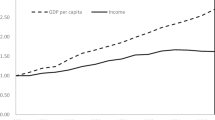Abstract
In a telephone survey 1000 adults were confronted with pairs of life saving programs that differed in number of lives saved and asked which program in each pair they would choose to implement. Respondents were also asked to rate qualitative program characteristics on 10 point scales. For most respondents, lives saved are significant in explaining program choices, as are psychological risk characteristics. The rate of technical substitution between these characteristics and lives saved is, however, inelastic. It is noteworthy that for about 20 percent of respondents, choices among programs appear to be insensitive to lives saved.
Similar content being viewed by others
References
Alberini, Anna. (1995). “Efficiency vs. Bias of Willingness-to-Pay Estimates: Bivariate and Interval-Data Models,” Journal of Environmental Economics and Management 29, 169–180.
Cameron, Trudy Ann, and John Quiggin. (1994). “Estimation Using Contingent Valuation Data from a ‘Dichotomous Choice With Follow-Up’ Questionnaire,” Journal of Environmental Economics and Management 27, 218–234.
Cropper, Maureen L., William N. Evans, Stephen J. Berardi, Maria M. Ducla-Soares, and Paul R. Portney. (1992). “The Determinants of Pesticide Regulation: A Statistical Analysis of EPA Decision Making,” Journal of Political Economy 100, 175–198.
Cropper, Maureen L., Sema K. Aydede, and Paul R. Portney. (1994). “Preferences for Life Saving Programs: How the Public Discounts Time and Age,” Journal of Risk and Uncertainty 8, 243–265.
Cropper, Maureen L., and Uma Subramanian. (1999). “Public Choices between Lifesaving Programs: How Important Are Lives Saved?” In Maureen Cropper ed., Valuing Environmental Benefits: Selected Essays of Maureen Cropper. Cheltenham, U.K.: Edward Elgar.
Desvousges, William H., and V. Kerry Smith. (1988). “Focus Groups and Risk Communication: The Science of Listening to Data,” Risk Analysis 8, 479–484.
Eddy, David M. (1989). “Screening for Breast Cancer,” Annals of Internal Medicine 111, 389–399.
Hanemann, W. Michael, John B. Loomis, and Barbara Kanninen. (1991). “Statistical Efficiency of Double Bounded Dichotomous Choice Contingent Valuation,” American Journal of Agricultural Economics 73, 1255–1263.
Horowitz, John K., and Richard T. Carson. (1991). “A Classification Tree for Predicting Consumer Preferences for Risk Reduction,” American Journal of Agricultural Economics 73, 1416–1421.
Horowitz, John K., and Richard T. Carson. (1992). “The Demand for Government Regulation of Environmental Health Risks.” Department of Agriculture and Resource Economics Working Paper, University of Maryland, College Park, Maryland.
Horowitz, John K., and Richard T. Carson. (1993). “Baseline Risk and Preferences for Reductions in Risk-to-Life,” Risk Analysis 13, 457–462.
Horowitz, John K. (1993). “Preferences for Pesticide Regulation,” American Journal of Agricultural Economics 76, 396–406.
Wesley A. Magat, W. Kip Viscusi, and Joel Huber. (1996). “A Reference Lottery Metric for Valuing Health,” Management Science 42, 1118–1130.
Mendeloff, John M., and Kaplan, Robert M. (1989). “Are Large Differences in Lifesaving Costs Justified? A Psychometric Study of the Relative Value Placed on Preventing Deaths,” Risk Analysis 9, 349–363.
Morrall, John F. (1986). “A Review of the Record,” Regulation 10, 25–34.
Slovic Paul, Baruch Fischhoff, and Sarah Lichtenstein. (1985). “Weighing the Risks.” In Robert W. Kates, Christoph Hohenemser, and Jeanne X. Kasperson eds., Perilous Progress: Managing the Hazards of Technology. Bounder, Colorado: Westview Press.
Tengs, Tammy O., Miriam E. Adams, Joseph S. Pliskin, Dana Gelb Safran, Joanna E. Siegel, Milton C. Weinstein, and John D. Graham. (1995). “Five-Hundred Life-Saving Interventions and Their Cost-Effectiveness,” Risk Analysis 15, 369–390.
U.S. Environmental Protection Agency. (1987). Unfinished Business: A Comparative Assessment of Environmental Problems. Office of Policy Analysis.
U.S. Environmental Protection Agency. (1990). Reducing Risk: Setting Priorities and Strategies for Environmental Protection. Report of the Science Advisory Board: Relative Risk Reduction Committee.
U.S. Environmental Protection Agency. (1991). A Consumer 's Guide to Radon, Technical Appendix. Office of Air and Radiation
U.S. Office of Management and Budget. (1993). Regulatory Program of the U.S. Washington, D.C.
Van Houtven, George, and Maureen L. Cropper. (1996). “When is a Life Too Costly to Save Evidence from U.S. Environmental Regulations,” Journal of Environmental Economics and Management 30, 348–368.
Viscusi, Kip W. (1992). Fatal Tradeoffs: Public and Private Responsibilities for Risk. Oxford: Oxford University Press.
Author information
Authors and Affiliations
Rights and permissions
About this article
Cite this article
Subramanian, U., Cropper, M. Public Choices Between Life Saving Programs: The Tradeoff Between Qualitative Factors and Lives Saved. Journal of Risk and Uncertainty 21, 117–149 (2000). https://doi.org/10.1023/A:1026525611689
Issue Date:
DOI: https://doi.org/10.1023/A:1026525611689




